
Erik Weisz, known as Harry Houdini, was a Hungarian-American escape artist, illusionist, and stunt performer, noted for his escape acts.
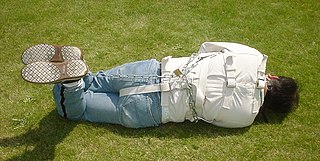
A straitjacket is a garment shaped like a jacket with long sleeves that surpass the tips of the wearer's fingers. Its most typical use is restraining people who may cause harm to themselves or others. Once the wearer slides their arms into the sleeves, the person restraining the wearer crosses the sleeves against the chest and ties the ends of the sleeves to the back of the jacket, ensuring the arms are close to the chest with as little movement as possible.
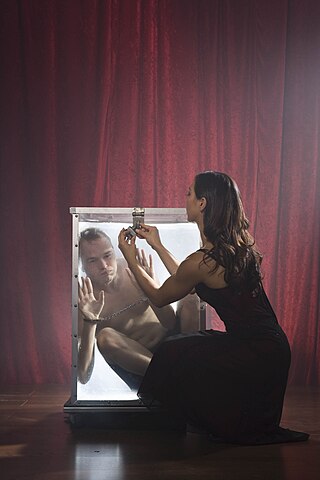
A predicament escape is any form of magic trick or escapology stunt in which the performer is trapped in an apparently dangerous situation and is required to escape from it. Classic examples include the Table of Death, Houdini's Chinese Water Torture Cell, Princess Tenko's escape from an exploding boat and the Upside Down Suspended Straitjacket escape, in which a performer is suspended high in the air from a burning rope.
This timeline of magic is a history of the performing art of illusion from B.C. to the present.
Thomas Solomon is an American escape artist and magician.

Ferenc Dezső Weisz, known as Theodore "Dash" Hardeen, was a Hungarian-American magician and escape artist who was the younger brother of Harry Houdini. Hardeen, who usually billed himself as the "brother of Houdini", was the founder of the Magician's Guild. Hardeen was the first magician to conceive escaping from a straitjacket in full view of the audience, rather than behind a curtain.
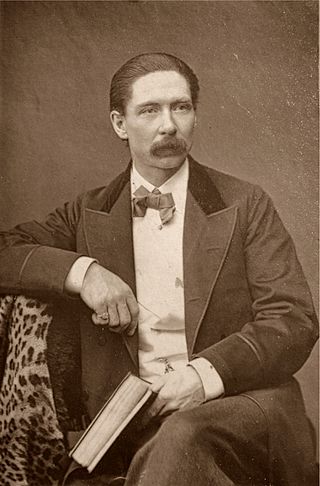
John Nevil Maskelyne was an English stage magician and inventor of the pay toilet, along with other Victorian-era devices. He worked with magicians George Alfred Cooke and David Devant, and many of his illusions are still performed today. His book Sharps and Flats: A Complete Revelation of the Secrets of Cheating at Games of Chance and Skill is considered a classic overview of card sharp practices. In 1914 he founded the Occult Committee, a group to "investigate claims to supernatural power and to expose fraud".
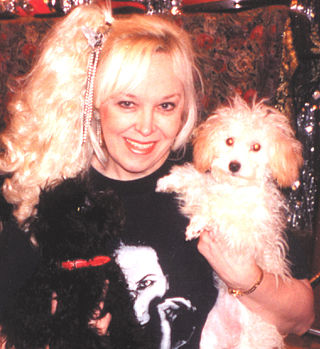
Dorothy Dietrich is an American stage magician and escapologist, best known for performing the bullet catch in her mouth and the first woman to perform a straitjacket escape while suspended hundreds of feet in the air from a burning rope. She was the first woman to gain prominence as an escape artist since the days of Houdini, breaking the glass ceiling for women in the field of escapes and magic.

The Chinese Water Torture Cell is a predicament escape made famous by Hungarian-American magician Harry Houdini. The illusion consists of three parts: first, the magician's feet are locked in stocks; next, he is suspended in mid-air from his ankles with a restraint brace; finally, he is lowered into a glass tank overflowing with water and the restraint is locked to the top of the cell.

Houdini is a 1953 American Technicolor biographical film from Paramount Pictures, produced by George Pal and Berman Swarttz, directed by George Marshall, that stars Tony Curtis and Janet Leigh. The film's screenplay, based upon the life of magician and escape artist Harry Houdini, was written by Philip Yordan, based on the book Houdini by Harold Kellock. The film's music score was by Roy Webb and the cinematography by Ernest Laszlo. The art direction was by Albert Nozaki and Hal Pereira, and the costume design by Edith Head.
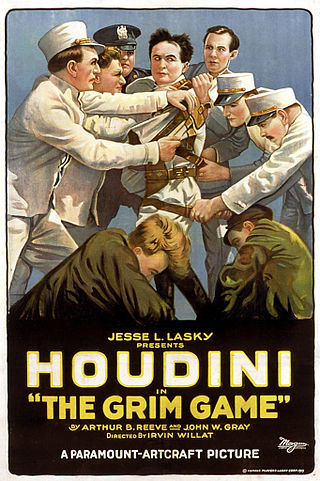
The Grim Game is a 1919 American silent drama film directed by Irvin Willat and starring Harry Houdini and Ann Forrest. The basic plotline serves as a showcase for Houdini's talent as an escapologist, stunt performer and aviator. As the story unfolds, a series of Houdini's trademark set-piece stunts and escapes are performed. When his tormentors chain him up and imprison him on numerous occasions, Houdini escapes. The film concludes with a climactic mid-air collision following an aircraft pursuit. Following the collision, Houdini is reunited with his fiancée.

Alan Alan was a British escapologist and magician. He originated tricks that have subsequently become familiar features of the repertoire of other performers and he was honoured by The Magic Circle.
Morgan the Escapist is a magic performer specialising in escapology. She is based in South Plainfield, New Jersey, USA, and often works with the magician John Bundy. She has also had careers as a theatrical designer and script writer. In October 2009, she received the title "Best female escape artist" at the World Magic Awards.

Magic, which encompasses the subgenres of illusion, stage magic, and close-up magic, among others, is a performing art in which audiences are entertained by tricks, effects, or illusions of seemingly impossible feats, using natural means. It is to be distinguished from paranormal magic which are effects claimed to be created through supernatural means. It is one of the oldest performing arts in the world.
Randolph Osborne Douglas was a British silversmith, artist and amateur escapologist, who worked under the stage name 'The Great Randini'. Douglas is said to have devised tricks for Harry Houdini. He later created a museum of curios in Castleton in Derbyshire.
Christopher Alfred Goode, better known as Chris Cross, is an English magician, escapologist, and former contortionist. He has performed worldwide and appeared on British television.

David Merlini is a Hungarian-Italian escape artist, and World Record holder, described by Expo 2015 as the world's most famous escapologist, currently serving as Director of The House of Houdini, the only Houdini museum in Europe.
Norman Bigelow was an American illusionist. He has been described by the Society of American Magicians as "one of America’s leading escape artists".
John Clempert was a Russian escape artist who became famous for his hanging tricks and for a legal dispute with Harry Houdini.
Norman Murray Carrington Walters, who used the mononym Murray, was an Australian escapologist and illusionist, who found international success between the 1920s and 1950s and settled in Britain.














